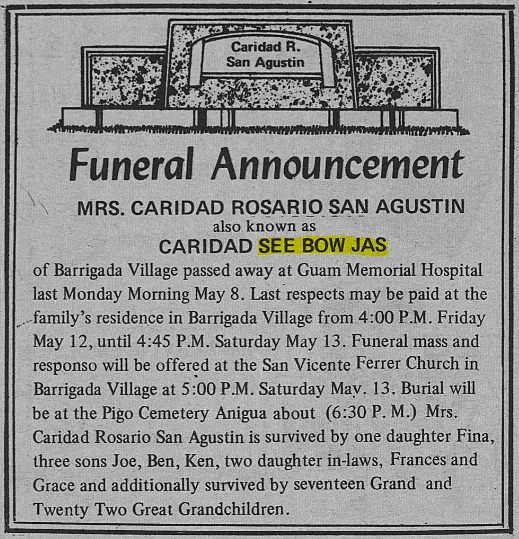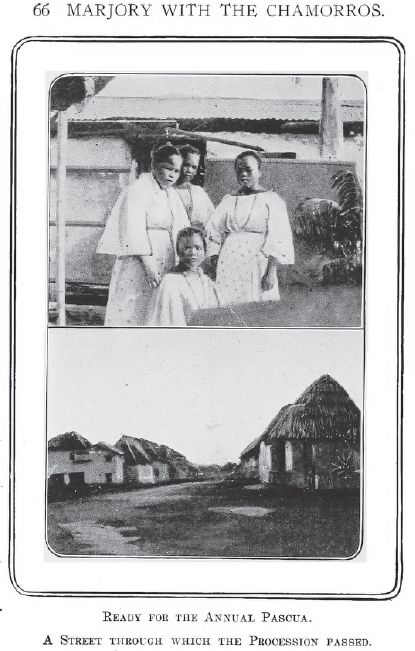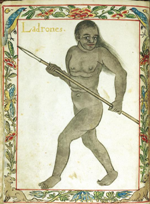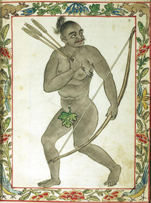Home
Phonetic Spelling of Chamorro Clan Names
- Details
- Written by: Bernard Punzalan

Marjory with the Chamorros (1907)
- Details
- Written by: Bernard Punzalan
Marjory with the Chamorros (1907)
Stevens, Mary C.
New York, The American Tract Society

What captured my attention to this book were the photos. Some of the pictures were taken by the author sometime in 1901 and 1902. Because this book is tied to the history of the Protestant mission on Guam, I am inclined to think that some of these photos are linked to the Taitano and Sablan families. There is definitely a mention in the book of "Little Joe Custino."
This book is in the public domain so enjoy the read and some of the interesting photos at the link provided below.
Database Update 7 April 2013
- Details
- Written by: Bernard Punzalan
The database has been updated and has grown from 289,917 to 291,183 names.
First Name-Nickname Dictionary Project
- Details
- Written by: Bernard Punzalan
In case some of you have not latched on to the CHamorro Roots ~ Hale' CHamoru FaceBook group, just yesterday (April 6, 2013 CHamorro ST) we launched the First Name-Nickname Dictionary Project. Here's the link (updated as necessary) to some of the information being collected: http://docs.com/RUE4
Some interesting notes that have occurred and I have commented on:
1. Some pieces of oral history are being revealed. This is great because there usually are stories behind a nickname; whether it be by someone's ta'dung accent or an incidental event. I don't know you tell us! The nickname may be unique and isolated within a particular family.
Some of the entries reminded me that my maternal aunties called me "Nono Boy." This had no bearing/relationship (that I know of) to my name Bernard. I must have done something as child that reminded them of a Nono. LOL…
…and oh, I just feel compelled to also state that no matter how old I am (ahem), my elders every now and then still refer to me as "Boy," when they ask me to do something for them. I am not offended by it, and recognize that my elders will always view me as a younger generation, and I acknowledge their seniority with respect.
2. The development of Chamorro orthography is considered to be fairly young compared to other languages; therefore, we will see a variety of spellings. So it is great to see people providing examples on how the nickname would be pronounced.
3. We can also observe some transitions of nicknames between Chamorro, Spanish and American influence. I'm sure those with Japanese, German and other foreign ancestry will have their own unique flavor too!
I am hopeful that one day a young Chamorro scholar will take all these projects to the next level of analyzing and writing more on these components of our rich, vibrant and unique Chamorro heritage.
Si Yu'os ma'ase todus hamyu manmana'patte guini. (I hope I said that right) Thank you all who contribute/share here.
First Rendition of a Chamorro
- Details
- Written by: Bernard Punzalan

 One of the earliest renditions of a Chamorro comes from a manuscript allegedly written sometime in the 1590's. The manuscript is contemporarily referred to as the "Boxer Codex." Just Google it or go to Wikipedia and you will find out more about Boxer Codex. The physical and digital copy of the manuscript is housed at Indiana University.
One of the earliest renditions of a Chamorro comes from a manuscript allegedly written sometime in the 1590's. The manuscript is contemporarily referred to as the "Boxer Codex." Just Google it or go to Wikipedia and you will find out more about Boxer Codex. The physical and digital copy of the manuscript is housed at Indiana University.
One of the interesting things of the many mysteries of this manuscript is that although the book cover is labeled "La Del Ladrones," there is only one picture of a Chamorro, which by the way happens to be the first picture in the book. The picture on the right (page 2) following the Chamorro is misleading to the point that one would think that the Chamorro people in the 16th Century had weaponry of bows and arrows, when there has been no archaeological or historical evidence to support it. It is believed that the man with the bow and arrows comes from either a Filipino or other Far Eastern tribe.
Page 69 of 84


